
Churches - Bevendean History Project

St Andrews Church, Moulsecoomb - part 1The First Church
With the shift of population from the centre of Brighton to the new and still developing housing on the outskirts of Brighton a new church was proposed.
In 1921 the Diocese of Chichester purchased the site for a Church at the junction of Colbourne Avenue and Hillside. At this time Moulsecoomb was part of the Parish of Patcham. Early in 1922 the Rev. J. Holroyde, Vicar of Patcham, oversaw the construction of a hut in the North West corner of the plot (about where the current vicarage is) which became the first St. Andrews’ church. The hut was an ex-army hut measuring 70 feet by 20 feet.
The second temporary church was a building brought from Lewes and was then called St Barnabas. It was the place where the Rev. Frederick Bickford Heard had officiated in Southover, Lewes.
On the 18th November 1922 The Bishop of Chichester the Rt Rev W. Burrows held a dedication service for St. Andrews’ and introduced the Curate in Charge, The Rev Bickford Heard.
The Rev Bickford Heard conducted the first marriage service in the church on 4th April 1923.
The first confirmation service at St Andrew’s Church was held on the 17th May 1923 and was conducted by the Bishop of Lewes.
In 1924 the Rev. Heard resigned due to ill health, he conducted his last marriage service on 24th April 1924 and his last service on 24th June 1924.
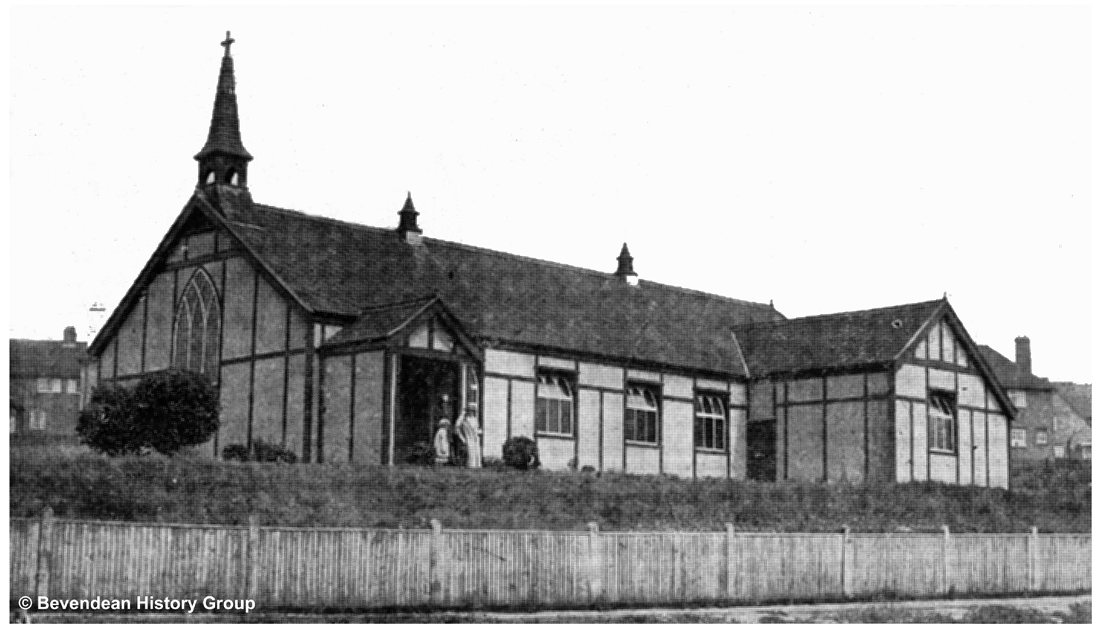
The second Moulsecoomb church in 1931. The first church was an Army hut converted to a church hall when the second temporary church was erected.
Rev William Harold Carpenter
The Rev. William Harold Carpenter B.A. from St. Michaels Church at Partridge Green succeeded the Rev Bickford Heard. He was licensed as Curate in charge of Moulsecoomb by Hugh Hordern, the Archdeacon of Lewes on Monday 7th July 1924 when a large congregation gathered in the church for a service of introduction and blessing, conducted by the Archdeacon.
The Rev. W. H. Carpenter left St. Andrews in 1931 after 7 years at the church.
The Parish of Moulsecoomb
The Parish of Moulsecoomb was set up in 1931, with an order published in the London Gazette on 2nd June 1931. Up until this time Moulsecoomb had been part of the Parish of Patcham.
The Rev. Leslie George Berrington was instituted as the first Vicar of Moulsecoomb at the temporary church of St Andrews on 12th July 1931.
The New St Andrew’s Church
The first spit was turned for the new church by the Bishop and Mrs Hett, the wife of the architect, on St Andrews’ Day, the 30th November 1932.
A report in the local paper stated that “Prayers were offered by the Bishop, and then Mrs Hett proceeded to turn the first piece of ground, thus starting the actual excavation for the foundations of the new church. The outline of the ground plan of the building was marked by flags that fluttered bravely in the fresh breeze.
The performance of such a ceremony by this lady was truly fitting, for had it not been for the generosity of Mr and Mrs Hett, who donated £6,000, it would have been impossible to commence the church at such an early date, and Moulsecoomb accords its gratitude to them for their splendid generosity and interest.”
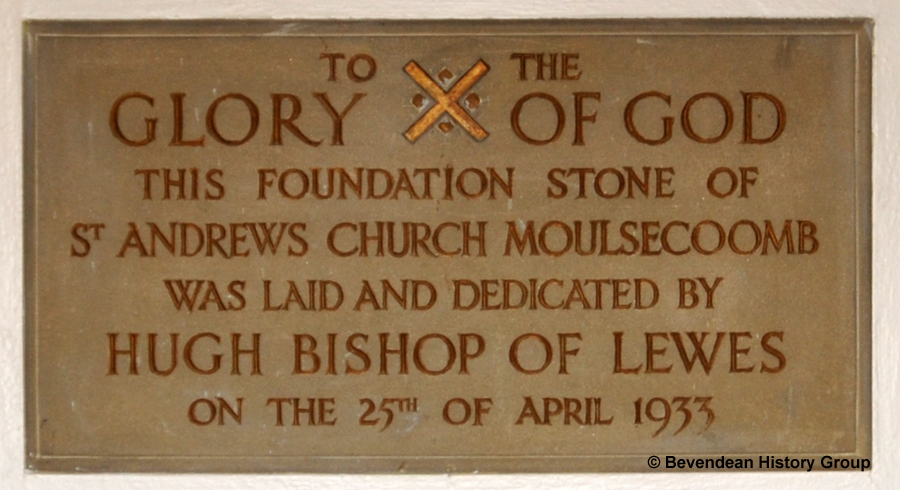
The foundation stone for the new church was laid by the Bishop of Lewes on 25th April 1933 in drenching rain. The stone was the gift of Mr W. J. Barber; and was inscribed by his son, Mr A. Barber, who was also the church organist at the time.
There was no Vicarage at this time and the Rev. Berrington lived at 22, Palmeira Square, Hove.
The last service in the old church took place on Sunday 17th June 1934.
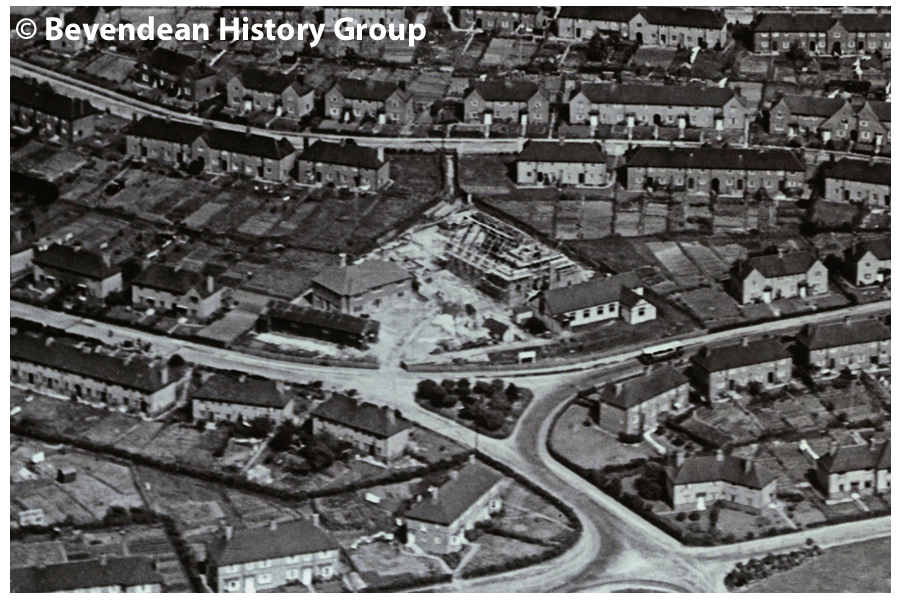
St Andrews Church viewed from the air in 1933 during construction. The Vicarage was constructed at the same time. The hut in the bottom left hand corner was first used as a church and later as a church hall. The second church is in the bottom right hand corner of the site.
Consecration of the New St Andrew’s Church
On Saturday 23rd June 1934 Bishop of Chichester (Dr. G. K. A. Bell consecrated the new church dedicated to St Andrew, at Moulsecoomb and charged the Church people of Moulsecoomb to be ‘fishers’ of men.’
The first Sunday in the new church was on 24th June 1934 when the celebrant was the Bishop of Chichester and the preacher the Bishop of Lewes.
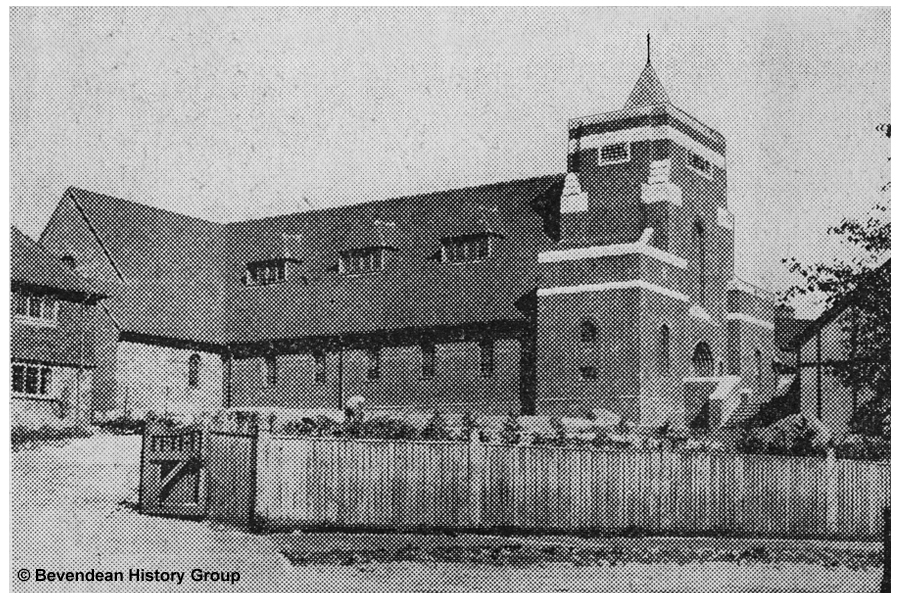
St Andrews Church in June 1934
Once the new church was in use the old church became the church hall and the hut previously used as a church hall was demolished. The Vicarage was built about the same time as the church.
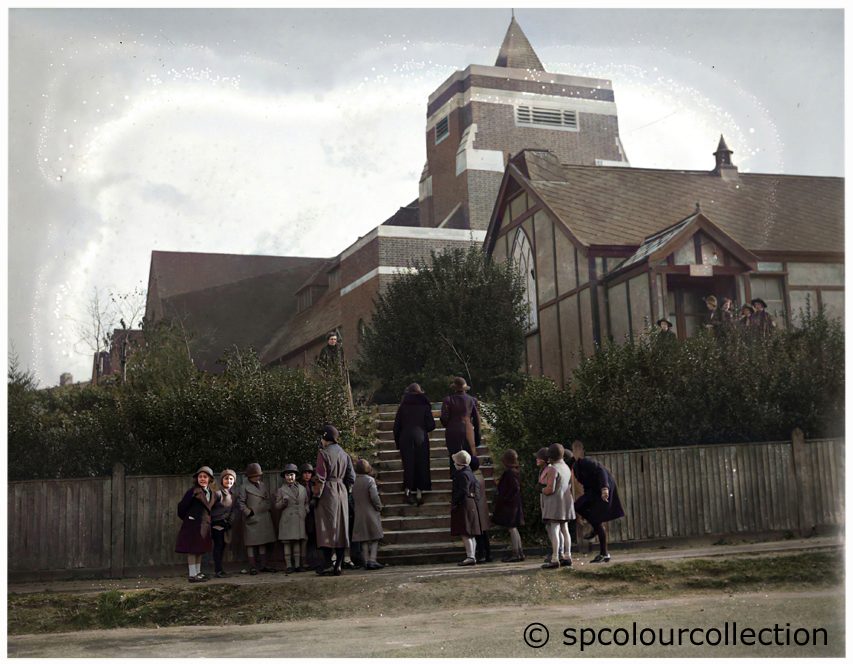
St Andrews Church photographed in 1938 showing the first church in the foreground used as the Church Hall, once the new church was completed in 1934, from The Southern Publishing Colour Collection 1927-1963, used with permission.
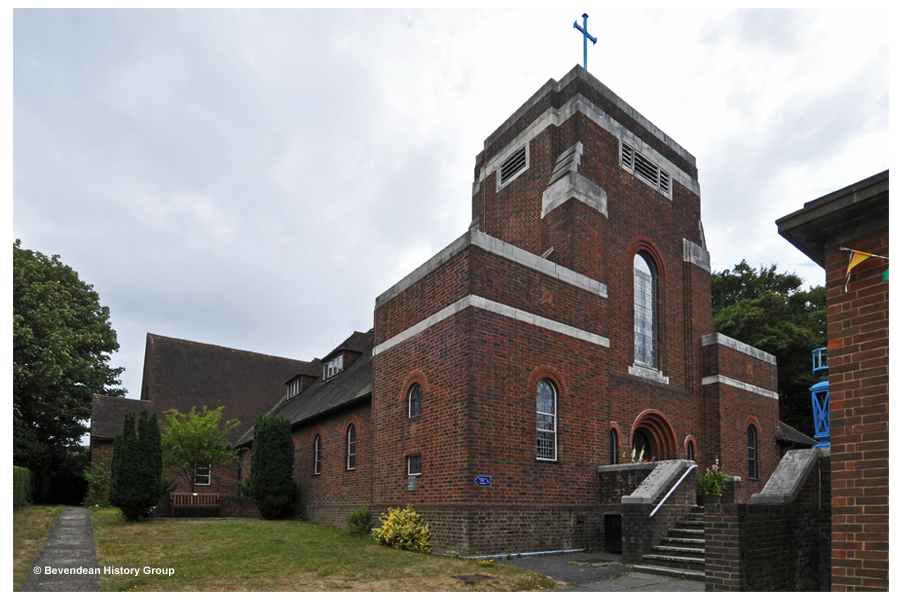
St Andrews church in July 2010
Church developments in the 1950s.
Two daughter churches of St Andrews where opened in the 1950s, both being created from converted farm barns, one at Lower Bevendean and the other at Coldean.
United Parish of Moulsecoomb, Stanmer and Falmer
The parish was united with Stanmer and Falmer from 1956 until 1976. From around 1956 to 1982 the parish was called Stanmer with Falmer and Moulsecoomb.
With the shift of population from the centre of Brighton to the new and still developing housing on the outskirts of Brighton a new church was proposed.
In 1921 the Diocese of Chichester purchased the site for a Church at the junction of Colbourne Avenue and Hillside. At this time Moulsecoomb was part of the Parish of Patcham. Early in 1922 the Rev. J. Holroyde, Vicar of Patcham, oversaw the construction of a hut in the North West corner of the plot (about where the current vicarage is) which became the first St. Andrews’ church. The hut was an ex-army hut measuring 70 feet by 20 feet.
The second temporary church was a building brought from Lewes and was then called St Barnabas. It was the place where the Rev. Frederick Bickford Heard had officiated in Southover, Lewes.
On the 18th November 1922 The Bishop of Chichester the Rt Rev W. Burrows held a dedication service for St. Andrews’ and introduced the Curate in Charge, The Rev Bickford Heard.
The Rev Bickford Heard conducted the first marriage service in the church on 4th April 1923.
The first confirmation service at St Andrew’s Church was held on the 17th May 1923 and was conducted by the Bishop of Lewes.
In 1924 the Rev. Heard resigned due to ill health, he conducted his last marriage service on 24th April 1924 and his last service on 24th June 1924.

The second Moulsecoomb church in 1931. The first church was an Army hut converted to a church hall when the second temporary church was erected.
Rev William Harold Carpenter
The Rev. William Harold Carpenter B.A. from St. Michaels Church at Partridge Green succeeded the Rev Bickford Heard. He was licensed as Curate in charge of Moulsecoomb by Hugh Hordern, the Archdeacon of Lewes on Monday 7th July 1924 when a large congregation gathered in the church for a service of introduction and blessing, conducted by the Archdeacon.
The Rev. W. H. Carpenter left St. Andrews in 1931 after 7 years at the church.
The Parish of Moulsecoomb
The Parish of Moulsecoomb was set up in 1931, with an order published in the London Gazette on 2nd June 1931. Up until this time Moulsecoomb had been part of the Parish of Patcham.
The Rev. Leslie George Berrington was instituted as the first Vicar of Moulsecoomb at the temporary church of St Andrews on 12th July 1931.
The New St Andrew’s Church
The first spit was turned for the new church by the Bishop and Mrs Hett, the wife of the architect, on St Andrews’ Day, the 30th November 1932.
A report in the local paper stated that “Prayers were offered by the Bishop, and then Mrs Hett proceeded to turn the first piece of ground, thus starting the actual excavation for the foundations of the new church. The outline of the ground plan of the building was marked by flags that fluttered bravely in the fresh breeze.
The performance of such a ceremony by this lady was truly fitting, for had it not been for the generosity of Mr and Mrs Hett, who donated £6,000, it would have been impossible to commence the church at such an early date, and Moulsecoomb accords its gratitude to them for their splendid generosity and interest.”

The foundation stone for the new church was laid by the Bishop of Lewes on 25th April 1933 in drenching rain. The stone was the gift of Mr W. J. Barber; and was inscribed by his son, Mr A. Barber, who was also the church organist at the time.
There was no Vicarage at this time and the Rev. Berrington lived at 22, Palmeira Square, Hove.
The last service in the old church took place on Sunday 17th June 1934.

St Andrews Church viewed from the air in 1933 during construction. The Vicarage was constructed at the same time. The hut in the bottom left hand corner was first used as a church and later as a church hall. The second church is in the bottom right hand corner of the site.
Consecration of the New St Andrew’s Church
On Saturday 23rd June 1934 Bishop of Chichester (Dr. G. K. A. Bell consecrated the new church dedicated to St Andrew, at Moulsecoomb and charged the Church people of Moulsecoomb to be ‘fishers’ of men.’
The first Sunday in the new church was on 24th June 1934 when the celebrant was the Bishop of Chichester and the preacher the Bishop of Lewes.

St Andrews Church in June 1934
Once the new church was in use the old church became the church hall and the hut previously used as a church hall was demolished. The Vicarage was built about the same time as the church.

St Andrews Church photographed in 1938 showing the first church in the foreground used as the Church Hall, once the new church was completed in 1934, from The Southern Publishing Colour Collection 1927-1963, used with permission.

St Andrews church in July 2010
Church developments in the 1950s.
Two daughter churches of St Andrews where opened in the 1950s, both being created from converted farm barns, one at Lower Bevendean and the other at Coldean.
United Parish of Moulsecoomb, Stanmer and Falmer
The parish was united with Stanmer and Falmer from 1956 until 1976. From around 1956 to 1982 the parish was called Stanmer with Falmer and Moulsecoomb.
| St Andrews Church - part 2 | St Andrews Church buildings |
| Newspaper Articles for St Andrews Church and the Parish of Moulsecombe | |
| Memories of a Vicars Daughter | |
